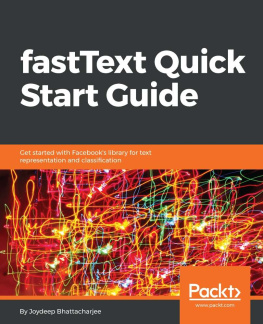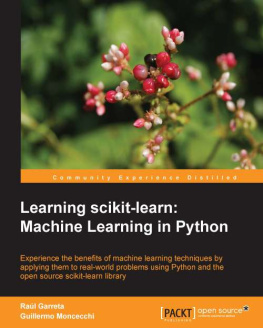Duygu Altinok - Mastering spaCy: An end-to-end practical guide to implementing NLP applications using the Python ecosystem
Here you can read online Duygu Altinok - Mastering spaCy: An end-to-end practical guide to implementing NLP applications using the Python ecosystem full text of the book (entire story) in english for free. Download pdf and epub, get meaning, cover and reviews about this ebook. year: 2021, publisher: Packt Publishing, genre: Home and family. Description of the work, (preface) as well as reviews are available. Best literature library LitArk.com created for fans of good reading and offers a wide selection of genres:
Romance novel
Science fiction
Adventure
Detective
Science
History
Home and family
Prose
Art
Politics
Computer
Non-fiction
Religion
Business
Children
Humor
Choose a favorite category and find really read worthwhile books. Enjoy immersion in the world of imagination, feel the emotions of the characters or learn something new for yourself, make an fascinating discovery.
- Book:Mastering spaCy: An end-to-end practical guide to implementing NLP applications using the Python ecosystem
- Author:
- Publisher:Packt Publishing
- Genre:
- Year:2021
- Rating:5 / 5
- Favourites:Add to favourites
- Your mark:
Mastering spaCy: An end-to-end practical guide to implementing NLP applications using the Python ecosystem: summary, description and annotation
We offer to read an annotation, description, summary or preface (depends on what the author of the book "Mastering spaCy: An end-to-end practical guide to implementing NLP applications using the Python ecosystem" wrote himself). If you haven't found the necessary information about the book — write in the comments, we will try to find it.
Build end-to-end industrial-strength NLP models using advanced morphological and syntactic features in spaCy to create real-world applications with ease
Key Features- Gain an overview of what spaCy offers for natural language processing
- Learn details of spaCys features and how to use them effectively
- Work through practical recipes using spaCy
spaCy is an industrial-grade, efficient NLP Python library. It offers various pre-trained models and ready-to-use features. Mastering spaCy provides you with end-to-end coverage of spaCys features and real-world applications.
Youll begin by installing spaCy and downloading models, before progressing to spaCys features and prototyping real-world NLP apps. Next, youll get familiar with visualizing with spaCys popular visualizer displaCy. The book also equips you with practical illustrations for pattern matching and helps you advance into the world of semantics with word vectors. Statistical information extraction methods are also explained in detail. Later, youll cover an interactive business case study that shows you how to combine all spaCy features for creating a real-world NLP pipeline. Youll implement ML models such as sentiment analysis, intent recognition, and context resolution. The book further focuses on classification with popular frameworks such as TensorFlows Keras API together with spaCy. Youll cover popular topics, including intent classification and sentiment analysis, and use them on popular datasets and interpret the classification results.
By the end of this book, youll be able to confidently use spaCy, including its linguistic features, word vectors, and classifiers, to create your own NLP apps.
What you will learn- Install spaCy, get started easily, and write your first Python script
- Understand core linguistic operations of spaCy
- Discover how to combine rule-based components with spaCy statistical models
- Become well-versed with named entity and keyword extraction
- Build your own ML pipelines using spaCy
- Apply all the knowledge youve gained to design a chatbot using spaCy
This book is for data scientists and machine learners who want to excel in NLP as well as NLP developers who want to master spaCy and build applications with it. Language and speech professionals who want to get hands-on with Python and spaCy and software developers who want to quickly prototype applications with spaCy will also find this book helpful. Beginner-level knowledge of the Python programming language is required to get the most out of this book. A beginner-level understanding of linguistics such as parsing, POS tags, and semantic similarity will also be useful.
Table of Contents- Getting Started with spaCy
- Core Operations with spaCy
- Linguistic Features
- Rule-Based Matching
- Working with Word Vectors and Semantic Similarity
- Putting Everything Together: Semantic Parsing with spaCy
- Customizing spaCy Models
- Text Classification with spaCy
- spaCy and Transformers
- Putting Everything Together: Designing Your Chatbot with spaCy
Duygu Altinok: author's other books
Who wrote Mastering spaCy: An end-to-end practical guide to implementing NLP applications using the Python ecosystem? Find out the surname, the name of the author of the book and a list of all author's works by series.

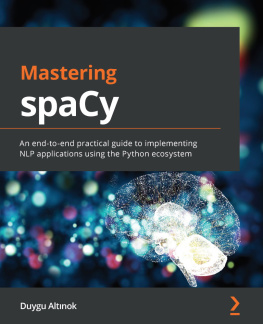

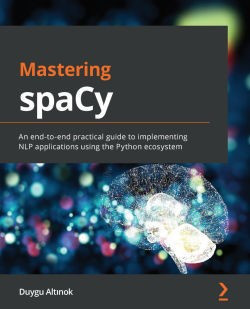
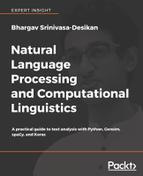
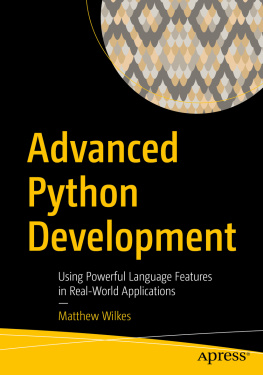

![Bhargav Srinivasa-Desikan [Bhargav Srinivasa-Desikan] - Natural Language Processing and Computational Linguistics: A Practical Guide to Text Analysis With Python, Gensim, spaCy, and Keras](/uploads/posts/book/119021/thumbs/bhargav-srinivasa-desikan-bhargav.jpg)
